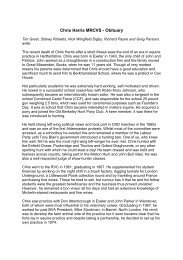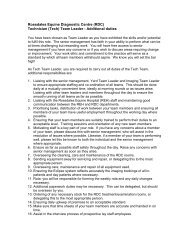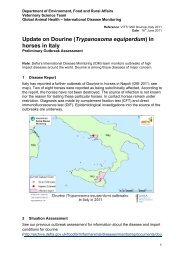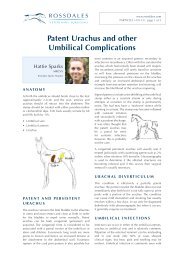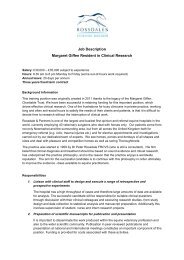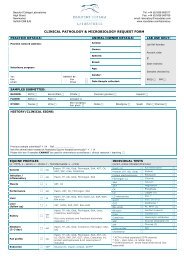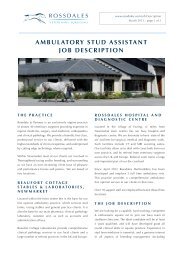EQUINE CLINICAL PATHOLOGY - Rossdale & Partners
EQUINE CLINICAL PATHOLOGY - Rossdale & Partners
EQUINE CLINICAL PATHOLOGY - Rossdale & Partners
You also want an ePaper? Increase the reach of your titles
YUMPU automatically turns print PDFs into web optimized ePapers that Google loves.
G u i d e t o e q u i n e c l i n i c a l p a t h o l o g y<br />
Kidney Biopsy<br />
Renal biopsy may be indicated where<br />
there is clinicopathological and ultrasonic<br />
evidence of kidney pathology. The<br />
technique is not without risk of injury<br />
to the horse and therefore should only<br />
be contemplated if clearly indicated and<br />
should only be performed with great care,<br />
using an ultrasound-guided technique.<br />
The right kidney is more easily accessible.<br />
Ultrasound scan examination is used to<br />
identify a suitable site, free from large blood<br />
vessels, in the posterior poles. The horse<br />
should be restrained, sedated in stocks.<br />
The skin over the kidney is clipped for<br />
imaging to identify the site for penetration,<br />
local anaesthesia is induced and the skin is<br />
then prepared as for surgical intervention.<br />
With the transducer coupled in a sterile<br />
surgical glove and sterile coupling gel on<br />
its surface, the kidney is imaged to find the<br />
ideal site for puncture. The biopsy needle is<br />
then introduced through the skin and into<br />
the renal parenchyma, sampling specific<br />
pathological features if visible.<br />
If biopsy of the left kidney is to be<br />
attempted, it is helpful for an assistant to<br />
palpate the kidney per rectum in order to<br />
stabilise it against the body wall, facilitating<br />
the ultrasound-guided biopsy technique.<br />
The tissue sample is fixed in 10% formol<br />
saline without delay and the needle channel<br />
may be swabbed immediately for bacterial<br />
culture.<br />
The horse should be stable-rested for at<br />
least 48 hours after biopsy and should be<br />
monitored for signs of ill health, particularly<br />
associated with renal haemorrhage.<br />
Endometrial Biopsy<br />
Endometrial biopsies are indicated for the<br />
routine investigation of barren mares and<br />
for the investigation of specific endometrial<br />
pathology. Ideally, they are more easily<br />
obtained and interpreted when the mare<br />
is in mid-dioestrus, but samples may be<br />
safely obtained at any stage of the oestrous<br />
cycle from any non-pregnant mare.<br />
Biopsies are obtained with special forceps<br />
(Kruuse UK or Rocket of London Ltd.),<br />
via the vagina and cervix. The mare is<br />
restrained as for routine gynaecological<br />
examinations with her tail bandaged,<br />
rectum evacuated of faeces, tail bandaged<br />
and perineum hygienically prepared. The<br />
mare is re-confirmed not pregnant. The<br />
sterile biopsy forceps are introduced into<br />
the mare’s vagina with a gloved hand, the<br />
cervix is identified (making sure that the<br />
urethral opening has not been accidentally<br />
entered) and the index finger is placed<br />
through the mare’s cervix into the uterine<br />
body. The forceps are then advanced along<br />
the index finger, as a guide, through the<br />
cervix and into the uterine body. The finger<br />
is then ‘hooked’ in the cervix, which may<br />
then be retracted caudally. This straightens<br />
the cervix and the uterine body, allows the<br />
biopsy forceps to fully enter the uterine<br />
body in a cranial direction and prevents<br />
53



